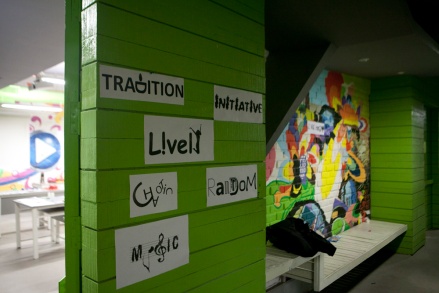
Words to describe Kathputli pasted on the walls by a different workshop group working with Image & Text who visited Kathputli colony for tour.

at a magicians house during our first tour of the colony.
Some questions about why our documentation and engagement in the community might be important for the future not only the communities but our own. Our own histories, experiences, and our own memory.
“THE HISTORY OF FORGETTING” is a book by Norman Klein. (via google books >> ) Los Angeles is a city which has long thrived on the continual re-creation of own myth. In this extraordinary and original work, Norman Klein examines the process of memory erasure in LA. In this he also imagines Walter Benjamin as an Angelino (name for people in LA.)
excerpts::
Just west of downtown Los Angeles, over fifty thousand housing units were torn down in the period 1933 to 1980, leaving an empty zone as noticeable as a meteor’s impact. Only some of the lots have since been filled. Many look the same as the day the
buildings went down, twenty or thirty years ago. High-rises stand directly beside barren hills, near weedy patches of old foundations. Along Sunset Boulevard, the stone staircases of former victorian houses now lead to nothing at all.
[…]
Business streets immediately west of Olvera Street remain as dead as a violated graveyard – a warning that downtown will be
forgettable even while it continues to be built. And yet the clues are still there. Two tunnels exit from downtown, but there is no hill above them, as if a large bird has flown away with it. Numerous lots west along Sunset Boulevard have steps on to what clearly used to be a house. Creaky Victorian cottages are stranded along streets just south of Sunset, cut short by a roaring freeway.
[…]
The need to chronicle their responses is very pressing in Los Angeles, particularly since the impact of Mike Davis’s City of Quartz has staked new ground in the history of how communities are destroyed by failed policies.
But their responses are very changeable, similar to memoirs after a political shock: new information drops in, old details disappear. And to add even more complication, in city hall, the myths that propel urban planners to demolish neighborhoods can be utterly phantasmagorical. And finally, there is the inattention from the public at large. Every morning for over thirty years, over 200,000 cars passed the bulldozing of these neighborhoods. Despite a few organizations that tried to rally support against these urban plans, there is virtually no record of complaint on a mass level. Most Angelinos I interview, even those who live immediately in the areas affected, have barely a dim memory that these neighborhoods stood at all. The overall effect resembles what psychologists call “distraction,” where one false memory allows another memory to be removed in plain view, without complaint – forgotten.
[…]
In the minds of consumers, the source of these erasures resembled what psychologists call an imago, an idealized face left over from childhood – a photograph, the color of mother’s dress on the day she took ill (the photological trace). For example, we see in
our mind’s eye the war in Vietnam primarily as two photographs: a general shooting a man in the head; a naked girl running toward the camera after being napalmed. These imagos are preserved inside a mental cameo frame (itself a fiction: who knows
what is inside?). If we concentrate, the imago seems to be waiting for us intact: a photo, a document, a table of statistics, an interview. It remains where we put it, but the details around it get lost, as if they were haunted, somewhat contaminated, but empty. Imagos are the sculpture that stands in the foreground next to negative space. Imagos are the false light that defines chiaroscuro. They are the rumor that seems haunted with memory, so satisfying that it keeps us from looking beyond it. The imago contains, as Kristeva describes so vividly, “once upon blotted-out time,” when “forgotten time crops up suddenly and condenses into a flash of lightning.”‘ However, when the flash is over, much of what remains as urban history is picturesque,’ in itself a form of erasure. Therefore, very soon into this project I realized that imagos – or phantom limbs, or whatever one called them – are extremely deceptive.
[…]
This is just from first two pages of the introduction. There’s much more to read.